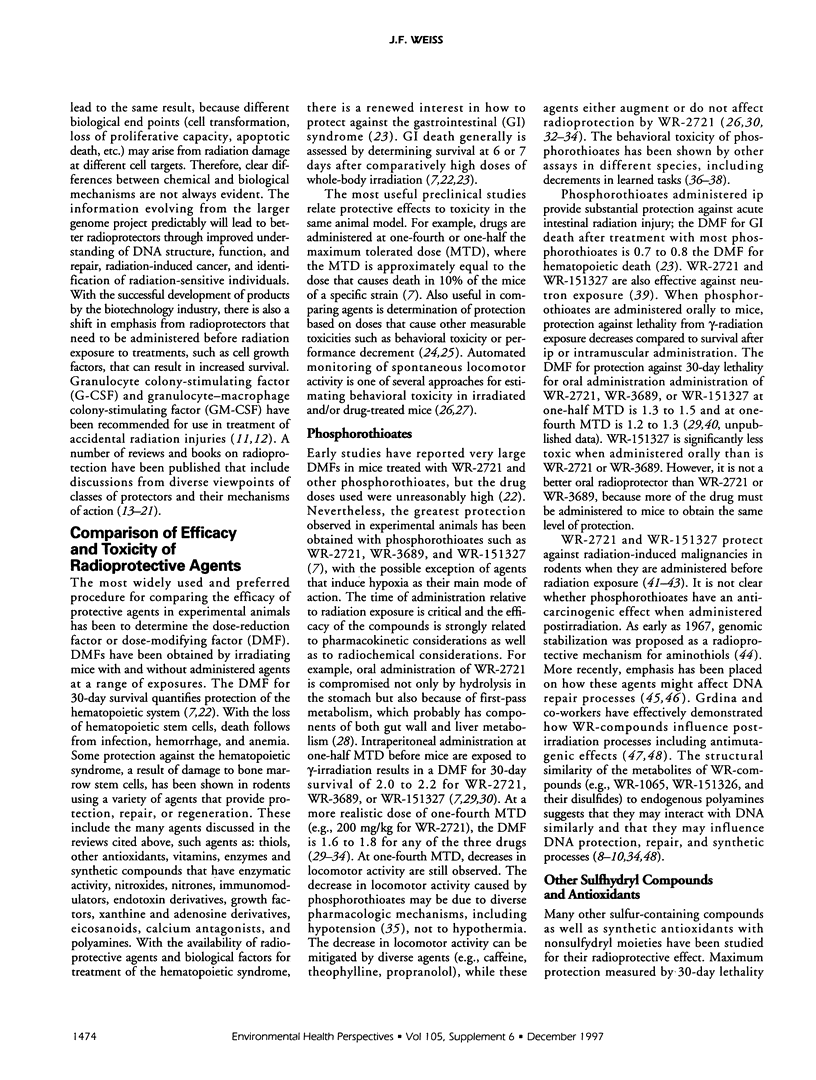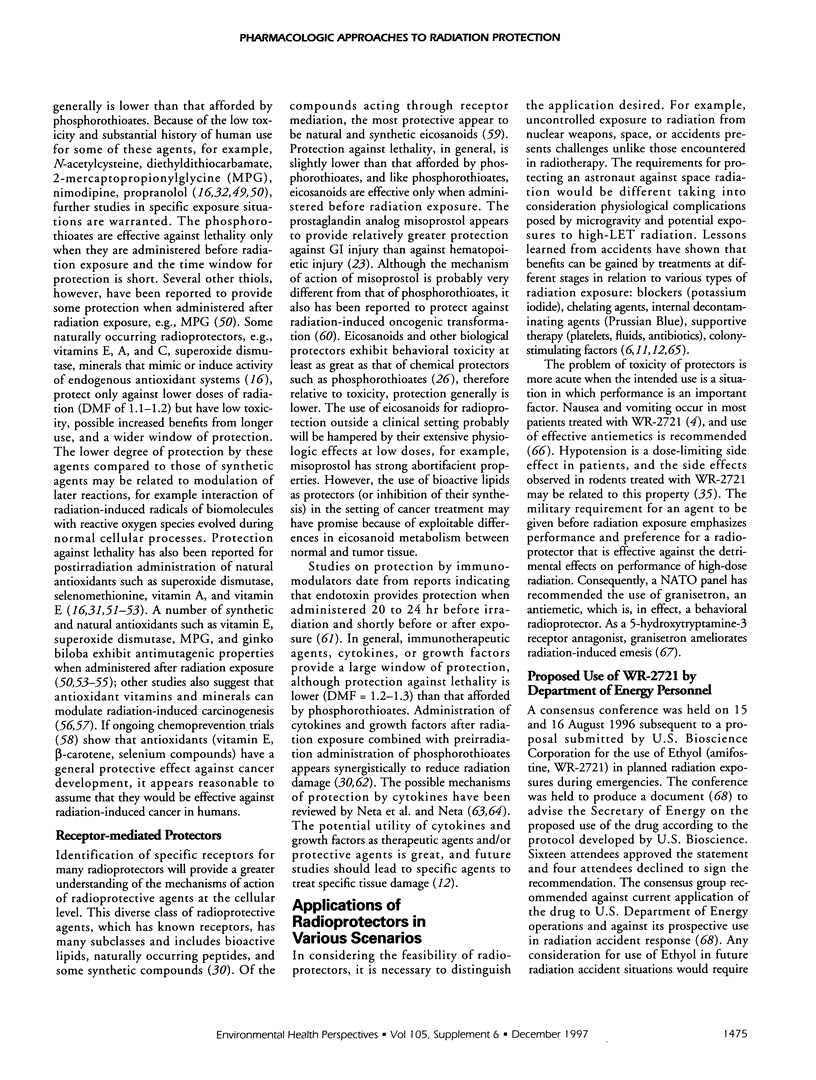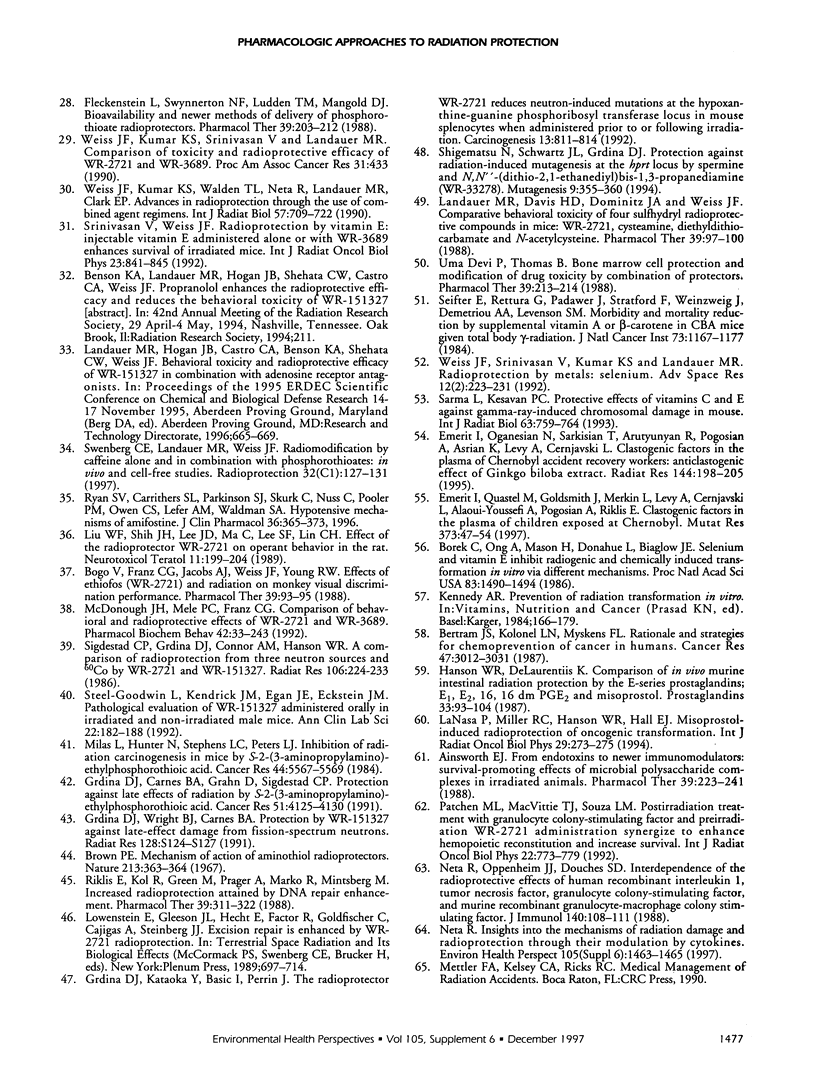Abstract
Studies on mechanisms of radioprotection are leading to a more rational use of protectors for different applications. In considering the feasibility of radioprotectors that act through various mechanisms, it is necessary to distinguish the application needed, e.g., protection against accidental external or internal exposures, acute high-dose radiation injury or low doses over a long period, high-LET radiation exposures during space flight, and protection of normal tissues of cancer patients who are undergoing therapy. Protectors generally are classified as either sulfhydryl compounds, other antioxidants, or receptor-mediated agents (e.g., bioactive lipids, cytokines, and growth factors). This review focuses on comparative radioprotection and toxicity studies in mice using the most effective phosphorothioate agents designated as WR-compounds and other classes of protectors. The superiority of phosphorothioates (WR-2721, WR-151327) as radioprotectors appears to be related to their high affinity for DNA and the similarity in structure of phosphorothioate metabolites to polyamines, and their effects on processes related to DNA structure and synthesis. Drug tolerance levels are available from clinical trials using WR-2721 (amifostine) and provide a basis for discussions of the disadvantages of phosphorothioate administration outside a clinical setting. In this regard, arguments are presented against the current use of WR-2721 by Department of Energy personnel for planned radiation exposures during emergencies. Future research may demonstrate, however, that pharmacologic agents could be useful in accident scenarios, especially when used in combination with therapeutic measures. Assessment of potential prophylactic measures should consider compatibility with therapeutic measures currently in use or ones that might be available in the future for the treatment of radiation injuries. These include antiemetics, purified stem cells, granulocyte colony-stimulating factor, and other cytokines. Their potential usefulness against radiation-induced mutagenesis of pre- and postexposure administration of phosphorothioates and other classes of protectors should be corroborated in humans.
Full text
PDF





Selected References
These references are in PubMed. This may not be the complete list of references from this article.
- Ainsworth E. J. From endotoxins to newer immunomodulators: survival-promoting effects of microbial polysaccharide complexes in irradiated animals. Pharmacol Ther. 1988;39(1-3):223–241. doi: 10.1016/0163-7258(88)90066-6. [DOI] [PubMed] [Google Scholar]
- Belkacémi Y., Ozsahin M., Pène F., Rio B., Sutton L., Laporte J. P., Touboul E., Gorin N. C., Laugier A. Total body irradiation prior to bone marrow transplantation: efficacy and safety of granisetron in the prophylaxis and control of radiation-induced emesis. Int J Radiat Oncol Biol Phys. 1996 Aug 1;36(1):77–82. doi: 10.1016/s0360-3016(96)00284-2. [DOI] [PubMed] [Google Scholar]
- Bertram J. S., Kolonel L. N., Meyskens F. L., Jr Rationale and strategies for chemoprevention of cancer in humans. Cancer Res. 1987 Jun 1;47(11):3012–3031. [PubMed] [Google Scholar]
- Bogo V. Behavioral radioprotection. Pharmacol Ther. 1988;39(1-3):73–78. doi: 10.1016/0163-7258(88)90041-1. [DOI] [PubMed] [Google Scholar]
- Bogo V., Franz C. G., Jacobs A. J., Weiss J. F., Young R. W. Effects of ethiofos (WR-2721) and radiation on monkey visual discrimination performance. Pharmacol Ther. 1988;39(1-3):93–95. doi: 10.1016/0163-7258(88)90045-9. [DOI] [PubMed] [Google Scholar]
- Bogo V., Jacobs A. J., Weiss J. F. Behavioral toxicity and efficacy of WR-2721 as a radioprotectant. Radiat Res. 1985 Nov;104(2 Pt 1):182–190. [PubMed] [Google Scholar]
- Borek C., Ong A., Mason H., Donahue L., Biaglow J. E. Selenium and vitamin E inhibit radiogenic and chemically induced transformation in vitro via different mechanisms. Proc Natl Acad Sci U S A. 1986 Mar;83(5):1490–1494. doi: 10.1073/pnas.83.5.1490. [DOI] [PMC free article] [PubMed] [Google Scholar]
- Brown D. Q., Graham W. J., 3rd, MacKenzie L. J., Pittock J. W., 3rd, Shaw L. M. Can WR-2721 be improved upon? Pharmacol Ther. 1988;39(1-3):157–168. doi: 10.1016/0163-7258(88)90057-5. [DOI] [PubMed] [Google Scholar]
- Brown P. E. Mechanism of action of aminothiol radioprotectors. Nature. 1967 Jan 28;213(5074):363–364. doi: 10.1038/213363a0. [DOI] [PubMed] [Google Scholar]
- Capizzi R. L., Oster W. Protection of normal tissue from the cytotoxic effects of chemotherapy and radiation by amifostine: clinical experiences. Eur J Cancer. 1995;31A Suppl 1:S8–13. doi: 10.1016/0959-8049(95)00144-8. [DOI] [PubMed] [Google Scholar]
- Coia L., Krigel R., Hanks G., Comis R., Algazy K., Peters R., McCulloch W., Schien P. A phase I study of WR-2721 in combination with total body irradiation (TBI) in patients with refractory lymphoid malignancies. Int J Radiat Oncol Biol Phys. 1992;22(4):791–794. doi: 10.1016/0360-3016(92)90525-m. [DOI] [PubMed] [Google Scholar]
- Constine L. S., Zagars G., Rubin P., Kligerman M. Protection by WR-2721 of human bone marrow function following irradiation. Int J Radiat Oncol Biol Phys. 1986 Aug;12(8):1505–1508. doi: 10.1016/0360-3016(86)90204-x. [DOI] [PubMed] [Google Scholar]
- Emerit I., Oganesian N., Sarkisian T., Arutyunyan R., Pogosian A., Asrian K., Levy A., Cernjavski L. Clastogenic factors in the plasma of Chernobyl accident recovery workers: anticlastogenic effect of Ginkgo biloba extract. Radiat Res. 1995 Nov;144(2):198–205. [PubMed] [Google Scholar]
- Emerit I., Quastel M., Goldsmith J., Merkin L., Levy A., Cernjavski L., Alaoui-Youssefi A., Pogossian A., Riklis E. Clastogenic factors in the plasma of children exposed at Chernobyl. Mutat Res. 1997 Jan 3;373(1):47–54. doi: 10.1016/s0027-5107(96)00187-x. [DOI] [PubMed] [Google Scholar]
- Fleckenstein L., Swynnerton N. F., Ludden T. M., Mangold D. J. Bioavailability and newer methods of delivery of phosphorothioate radioprotectors. Pharmacol Ther. 1988;39(1-3):203–212. doi: 10.1016/0163-7258(88)90062-9. [DOI] [PubMed] [Google Scholar]
- Foye W. O. Radiation-protective agents in mammals. J Pharm Sci. 1969 Mar;58(3):283–300. doi: 10.1002/jps.2600580302. [DOI] [PubMed] [Google Scholar]
- Grdina D. J., Carnes B. A., Grahn D., Sigdestad C. P. Protection against late effects of radiation by S-2-(3-aminopropylamino)-ethylphosphorothioic acid. Cancer Res. 1991 Aug 15;51(16):4125–4130. [PubMed] [Google Scholar]
- Grdina D. J., Kataoka Y., Basic I., Perrin J. The radioprotector WR-2721 reduces neutron-induced mutations at the hypoxanthine-guanine phosphoribosyl transferase locus in mouse splenocytes when administered prior to or following irradiation. Carcinogenesis. 1992 May;13(5):811–814. doi: 10.1093/carcin/13.5.811. [DOI] [PubMed] [Google Scholar]
- Grdina D. J., Shigematsu N., Dale P., Newton G. L., Aguilera J. A., Fahey R. C. Thiol and disulfide metabolites of the radiation protector and potential chemopreventive agent WR-2721 are linked to both its anti-cytotoxic and anti-mutagenic mechanisms of action. Carcinogenesis. 1995 Apr;16(4):767–774. doi: 10.1093/carcin/16.4.767. [DOI] [PubMed] [Google Scholar]
- Grdina D. J., Wright B. J., Carnes B. A. Protection by WR-151327 against late-effect damage from fission-spectrum neutrons. Radiat Res. 1991 Oct;128(1 Suppl):S124–S127. [PubMed] [Google Scholar]
- Hanson W. R., DeLaurentiis K. Comparison of in vivo murine intestinal radiation protection by E-prostaglandins. Prostaglandins. 1987;33 (Suppl):93–104. doi: 10.1016/0090-6980(87)90052-9. [DOI] [PubMed] [Google Scholar]
- Holwitt E. A., Koda E., Swenberg C. E. Enhancement of topoisomerase I-mediated unwinding of supercoiled DNA by the radioprotector WR-33278. Radiat Res. 1990 Oct;124(1):107–109. [PubMed] [Google Scholar]
- Kligerman M. M., Turrisi A. T., 3rd, Urtasun R. C., Norfleet A. L., Phillips T. L., Barkley T., Rubin P. Final report on phase I trial of WR-2721 before protracted fractionated radiation therapy. Int J Radiat Oncol Biol Phys. 1988 Jun;14(6):1119–1122. doi: 10.1016/0360-3016(88)90387-2. [DOI] [PubMed] [Google Scholar]
- LaNasa P., Miller R. C., Hanson W. R., Hall E. J. Misoprostol-induced radioprotection of oncogenic transformation. Int J Radiat Oncol Biol Phys. 1994 May 15;29(2):273–275. doi: 10.1016/0360-3016(94)90274-7. [DOI] [PubMed] [Google Scholar]
- Landauer M. R., Davis H. D., Dominitz J. A., Weiss J. F. Comparative behavioral toxicity of four sulfhydryl radioprotective compounds in mice: WR-2721, cysteamine, diethyldithiocarbamate, and N-acetylcysteine. Pharmacol Ther. 1988;39(1-3):97–100. doi: 10.1016/0163-7258(88)90046-0. [DOI] [PubMed] [Google Scholar]
- Landauer M. R., Davis H. D., Dominitz J. A., Weiss J. F. Dose and time relationships of the radioprotector WR-2721 on locomotor activity in mice. Pharmacol Biochem Behav. 1987 Jul;27(3):573–576. doi: 10.1016/0091-3057(87)90370-4. [DOI] [PubMed] [Google Scholar]
- Landauer M. R., Davis H. D., Kumar K. S., Weiss J. F. Behavioral toxicity of selected radioprotectors. Adv Space Res. 1992;12(2-3):273–283. doi: 10.1016/0273-1177(92)90117-g. [DOI] [PubMed] [Google Scholar]
- Liu W. F., Shih J. H., Lee J. D., Ma C., Lee S. F., Lin C. H. Effect of the radioprotector WR-2721 on operant behavior in the rat. Neurotoxicol Teratol. 1989 May-Jun;11(3):199–204. doi: 10.1016/0892-0362(89)90059-7. [DOI] [PubMed] [Google Scholar]
- McDonough J. H., Mele P. C., Franz C. G. Comparison of behavioral and radioprotective effects of WR-2721 and WR-3689. Pharmacol Biochem Behav. 1992 Jun;42(2):233–243. doi: 10.1016/0091-3057(92)90521-g. [DOI] [PubMed] [Google Scholar]
- Milas L., Hunter N., Stephens L. C., Peters L. J. Inhibition of radiation carcinogenesis in mice by S-2-(3-aminopropylamino)-ethylphosphorothioic acid. Cancer Res. 1984 Dec;44(12 Pt 1):5567–5569. [PubMed] [Google Scholar]
- Neta R. Modulation with cytokines of radiation injury: suggested mechanisms of action. Environ Health Perspect. 1997 Dec;105 (Suppl 6):1463–1465. doi: 10.1289/ehp.97105s61463. [DOI] [PMC free article] [PubMed] [Google Scholar]
- Neta R., Oppenheim J. J., Douches S. D. Interdependence of the radioprotective effects of human recombinant interleukin 1 alpha, tumor necrosis factor alpha, granulocyte colony-stimulating factor, and murine recombinant granulocyte-macrophage colony-stimulating factor. J Immunol. 1988 Jan 1;140(1):108–111. [PubMed] [Google Scholar]
- Patchen M. L., MacVittie T. J., Souza L. M. Postirradiation treatment with granulocyte colony-stimulating factor and preirradiation WR-2721 administration synergize to enhance hemopoietic reconstitution and increase survival. Int J Radiat Oncol Biol Phys. 1992;22(4):773–779. doi: 10.1016/0360-3016(92)90522-j. [DOI] [PubMed] [Google Scholar]
- Patt H. M., Tyree E. B., Straube R. L., Smith D. E. Cysteine Protection against X Irradiation. Science. 1949 Aug 26;110(2852):213–214. doi: 10.1126/science.110.2852.213. [DOI] [PubMed] [Google Scholar]
- Perspectives in radioprotection. Proceedings of the symposium. Bethesda, Maryland, 13-14 March 1987. Pharmacol Ther. 1988;39(1-3):1–414. [PubMed] [Google Scholar]
- Riklis E., Kol R., Green M., Prager A., Marko R., Mintsberg M. Increased radioprotection attained by DNA repair enhancement. Pharmacol Ther. 1988;39(1-3):311–322. doi: 10.1016/0163-7258(88)90077-0. [DOI] [PubMed] [Google Scholar]
- Ryan S. V., Carrithers S. L., Parkinson S. J., Skurk C., Nuss C., Pooler P. M., Owen C. S., Lefer A. M., Waldman S. A. Hypotensive mechanisms of amifostine. J Clin Pharmacol. 1996 Apr;36(4):365–373. doi: 10.1002/j.1552-4604.1996.tb04214.x. [DOI] [PubMed] [Google Scholar]
- Sarma L., Kesavan P. C. Protective effects of vitamins C and E against gamma-ray-induced chromosomal damage in mouse. Int J Radiat Biol. 1993 Jun;63(6):759–764. doi: 10.1080/09553009314552161. [DOI] [PubMed] [Google Scholar]
- Savoye C., Swenberg C., Hugot S., Sy D., Sabattier R., Charlier M., Spotheim-Maurizot M. Thiol WR-1065 and disulphide WR-33278, two metabolites of the drug ethyol (WR-2721), protect DNA against fast neutron-induced strand breakage. Int J Radiat Biol. 1997 Feb;71(2):193–202. doi: 10.1080/095530097144319. [DOI] [PubMed] [Google Scholar]
- Seifter E., Rettura G., Padawer J., Stratford F., Weinzweig J., Demetriou A. A., Levenson S. M. Morbidity and mortality reduction by supplemental vitamin A or beta-carotene in CBA mice given total-body gamma-radiation. J Natl Cancer Inst. 1984 Nov;73(5):1167–1177. [PubMed] [Google Scholar]
- Shigematsu N., Schwartz J. L., Grdina D. J. Protection against radiation-induced mutagenesis at the hprt locus by spermine and N,N"-(dithiodi-2,1-ethanediyl)bis-1,3-propanediamine (WR-33278). Mutagenesis. 1994 Jul;9(4):355–360. doi: 10.1093/mutage/9.4.355. [DOI] [PubMed] [Google Scholar]
- Sigdestad C. P., Grdina D. J., Connor A. M., Hanson W. R. A comparison of radioprotection from three neutron sources and 60Co by WR-2721 and WR-151327. Radiat Res. 1986 May;106(2):224–233. [PubMed] [Google Scholar]
- Srinivasan V., Weiss J. F. Radioprotection by vitamin E: injectable vitamin E administered alone or with WR-3689 enhances survival of irradiated mice. Int J Radiat Oncol Biol Phys. 1992;23(4):841–845. doi: 10.1016/0360-3016(92)90657-4. [DOI] [PubMed] [Google Scholar]
- Steel-Goodwin L., Kendrick J. M., Egan J. E., Eckstein J. M. Pathological evaluation of WR-151327 administered orally in irradiated and non-irradiated male mice. Ann Clin Lab Sci. 1992 May-Jun;22(3):182–188. [PubMed] [Google Scholar]
- Uma Devi P., Thomas B. Bone marrow cell protection and modification of drug toxicity by combination of protectors. Pharmacol Ther. 1988;39(1-3):213–214. doi: 10.1016/0163-7258(88)90063-0. [DOI] [PubMed] [Google Scholar]
- Washburn L. C., Rafter J. J., Hayes R. L. Prediction of the effective radioprotective dose of WR-2721 in humans through an interspecies tissue distribution study. Radiat Res. 1976 Apr;66(1):100–105. [PubMed] [Google Scholar]
- Weiss J. F., Kumar K. S., Walden T. L., Neta R., Landauer M. R., Clark E. P. Advances in radioprotection through the use of combined agent regimens. Int J Radiat Biol. 1990 Apr;57(4):709–722. doi: 10.1080/09553009014550881. [DOI] [PubMed] [Google Scholar]
- Weiss J. F., Srinivasan V., Kumar K. S., Landauer M. R. Radioprotection by metals: selenium. Adv Space Res. 1992;12(2-3):223–231. doi: 10.1016/0273-1177(92)90112-b. [DOI] [PubMed] [Google Scholar]
- Yuhas J. M., Storer J. B. Chemoprotection against three modes of radiation death in the mouse. Int J Radiat Biol Relat Stud Phys Chem Med. 1969 May;15(3):233–237. doi: 10.1080/09553006914550411. [DOI] [PubMed] [Google Scholar]


